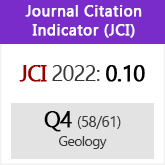Geological concepts in the architectural works of Fernando Menis in Tenerife
DOI:
https://doi.org/10.21701/bolgeomin/134.1/006Keywords:
Architecture, Fernando Menis, Geology, Tectonics, VolcanosAbstract
This work relates the various phenomena that act in the earth’s crust and the geological materials with ways of projecting architecture. To carry out this reflection, the work has been divided into two essays. The first one, theoretical, exposes the relations which exist between geology and architecture. It describes, on one hand, the importance of knowing the mechanical behavior of materials; on the other hand, it refers to the relationship of architecture with its environment and in particular the benefits that can be gained from it; in a final section, the types of geological processes which have had influence in the architecture are presented. The second essay of the paper applies the theories previously announced with the description of some selected projects. Due to its close relationship with the matter and energy of the Earth, the work by architect Fernando Menis has been chosen to perform the analysis. The description is divided into four different projects: Hatching, El Guincho pool, Santísimo Redentor church and Insular Athletics Centre in Tenerife, chosen as representative of each geological phenomenon considered. Finally, one last case study, the MAGMA Congress building is analyzed as a comprehensive example where all the above phenomena are exposed.
Downloads
References
AA. VV. (2005). Megalito urbano. Palacio de congresos, Tenerife. Arquitectura Viva, 101, 74-83.
AA. VV. (2012). De vuelta a la Arcadia Wang Shu y Lu Wenyu. Arquitectura Viva, 144, 20-23.
Aalto, A. (2000). La arquitectura en el paisaje de Finlandia Central. In: A. Aalto. (Ed.), De palabra y por escrito. El Croquis Editorial, El Escorial, 33-35.
Abouyoub, H. (2014). Fundamental(ism)s. Dosier de Prensa del pabellón para la bienal de Venecia, 5-6.
Aparicio Guisado, J. M. (2007). El hormigón y Aristóteles. Tectónica, 25, 9.
Assante, D. (2008). Centro Insular de Atletismo. Tíncer, Santa Cruz de Tenerife. In: Tribuna de la Construcción, 81/82, 254-305.
Bellido Mulas, F., Gómez Sainz de Aja, J. A., and Barrera, J. L. Mapa Geológico Digital continuo E. 1:25.000, Zona Canarias -Tenerife (Zona-2913) in GEODE. Mapa Geológico Digital continuo de España. [en línea].[fecha de consulta 06/09/2021]. Available in: http://info.igme.es/cartografiadigital/geologica/geodezona.aspx?id=Z2913
Bergdoll, B. (2016). Arquitectura geológica en la era global. AV Monografías. Arquitectura Viva, 181, 6-20.
Boixereu Vila, E. (2016). Evolución histórica de la cartografía geológica en España: desde sus orígenes hasta los mapas de Verneuil y Collomb (1864) y Maestre (1864). Tesis Doctoral Univ. Politécnica de Madrid, Archivo Digital UPM 387 pp.
Chueca Goitia, F. (1965). Capítulo I: Arquitectura prehistórica. In: F. Chueca Goitia (Ed.), Historia de la arquitectura española. Tomo I: Edad Antigua, Edad Media. Fundación Cultural Santa Teresa, Ávila, 1-18.
Dessandier, D., Sayagh, S., Bromlet, P., and Leroux, L. (2009). La pierre de construction, matériau du développement durable. Géosciences, 10, 8-10.
Fernández-Galiano, L. (2014). Obras topográficas. Arquitectura Viva, 166, 3.
Fisac, M. (1997). Durable-traccionable. Tectónica: monografías de arquitectura, tecnología y construcción, 5, 2.
Fujimoto, S. (2010). Futuro Primitivo. El Croquis, 151, 193-213.
Goldfinger, M. (1970). Relación con el ambiente natural. Antes de la Arquitectura, Edificación y hábitat anónimos en los países mediterráneos. Editorial Gustavo Gili, Barcelona, 11 pp.
Juárez, A. (2007). La materia como nuevo paisaje de la arquitectura. En: La materia de la arquitectura. I Congreso Internacional de Arquitectura de la Fundación Miguel Fisac. Almagro, 143-152.
Kepes, G. (1956). The new landscape in art and science. P. Theobald, Chicago, 383 pp.
Manrique, C. (1988) Lanzarote. Arquitectura inédita. Cabildo Insular de Lanzarote, Lanzarote, 262 pp.
Menis, F. (2007). Razón y Emoción. In: F. Menis (Ed.): Arquitectura: razón + emoción. D.L. ACTAR, Barcelona, 15-17.
Mercader, Mª. P., Olivares, M., and Ramírez de Avellano, A. (2012). Modelo de cuantificación del consumo energético en edificación. Materiales de Construcción, 62(308), 567-582. https://doi.org/10.3989/mc.2012.02411
Pallasmaa, J. (2015). Las bondades de la contención. In: J. Rodríguez, and C. Seoane (Eds.) Siza x Siza. Fundación Arquia/temas, Madrid, 25.
Porcel, J., and Prieto, B. (2007). MAGMA Arte & Congresos. El agua entre las rocas. In: F. Menis (Ed.), Arquitectura: razón + emoción. D.L. ACTAR, Barcelona, 136-155.
Torroja Miret, E. (2007). Los materiales clásicos. In: J.A. Torroja (Ed.), Razón y ser de los tipos estructurales. Colección: Ciencias, Humanidades e Ingeniería. Colegio de Ingenieros de Caminos, Canales y Puertos, D.L., Madrid, (Vol. 318, pp. 37-50).
Virilio, P. (1994). Bunker Archaeology. Princeton Architectural Press, Nueva York.
Downloads
Published
How to Cite
Issue
Section
License
Copyright (c) 2024 Consejo Superior de Investigaciones Científicas (CSIC)

This work is licensed under a Creative Commons Attribution 4.0 International License.
© CSIC. Manuscripts published in both the printed and online versions of this Journal are the property of Consejo Superior de Investigaciones Científicas, and quoting this source is a requirement for any partial or full reproduction.
All contents of this electronic edition, except where otherwise noted, are distributed under a “Creative Commons Attribution 4.0 International” (CC BY 4.0) License. You may read here the basic information and the legal text of the license. The indication of the CC BY 4.0 License must be expressly stated in this way when necessary.
Self-archiving in repositories, personal webpages or similar, of any version other than the published by the Editor, is not allowed.















